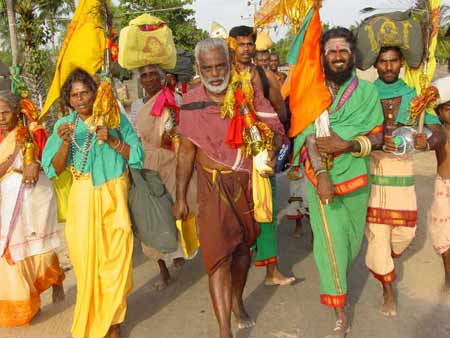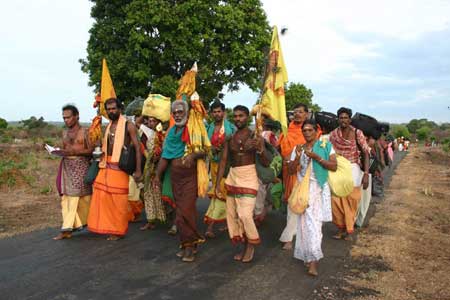
|
||||||||||||
|
| ||||||||||||
 2006 Pada Yatra pilgrims cross Yala jungle, reach Kataragama
(COLOMBO) Sinhalese, Tamil and foreign devotees of all ages are now trekking through Yala National Park as the traditional pada yatra foot pilgrims cross Kataragama Kaele, ‘the God's own Forest'. The pilgrims will cross nearly a hundred kilometers of jungle tracks to reach Kataragama in time for the Esala festival flag-hoisting ceremony on 26 July. The Pada Yatra pilgrims this year assembled from all over the island at Verugal Kataragama Devale on 25 June. Their small party grew into a colorful band of pilgrims attired in the characteristic red, yellow, or green garments typical of God Skanda's pilgrim devotees. Villagers in Batticaloa and Ampara districts have been astonished and delighted to see the spirited pilgrims, and gladly offer traditional offerings of dana and hospitality. Not only villagers, but security forces too have been offering the pilgrims dana. Many duty personnel shout ‘Haro Hara!' (‘Hallelujah') to cheer the pilgrims on. Villagers typically make vows to join the Pada Yatra as it passes through their own village, so the parties of pilgrims tend to grow day by day. With just a few days remaining before the flag-hoisting ceremonies at Okanda and Kataragama, thousand of pilgrims are expected to join or follow the pilgrims as they pass through Yala National Park. Some villages, like Mamangam near Batticaloa and others, have formed their own pada yatra societies of a hundred members or more, most of whom set out from popular starting points like Pottuvil and Okanda in the second week of July. With the Okanda Murugan Devale and Kataragama Maha Devale flag-hoisting ceremonies both occurring on 26 July, several thousands of foot pilgrims are now on the move as The Sunday Times goes to press. In recent years, the Pada Yatra tradition had been making a comeback after facing near-extinction following the 1983 ethnic riots. Only with the formation of the Kataragama Devotees Trust in 1988 and subsequent efforts to revive the tradition did pilgrims begin to turn out again in substantial numbers in the mid-1990's. HazardsWildlife Department officials, expecting another big turnout this year, are monitoring the flow of pilgrims who walk from Pottuvil via Okanda and Kumuna, through the Strict Natural Reserve to the banks of the Menik Ganga and thence to Kataragama. Living Heritage Trust volunteers, also walking on foot, monitor environmental and health conditions inside the park during the height of the Pada Yatra season. According to Living Heritage spokesman Manik Sandrasagra, the rush of inexperienced pilgrims through Yala brings with it environmental and health hazards. "This year we are again helping the Wildlife Department to minimize the fire hazard, reduce littering in the park, and maintain public health especially by monitoring sources of drinking water." "The Wildlife Department has been making admirable efforts to protect the park while also trying to meet the pilgrims' needs, especially for safe drinking water. But with thousands of pilgrims crossing at once, it is no easy task." Ancient TraditionSince 1988 the Kataragama Devotees Trust has annually coordinated the yatra by notifying devotees and temples all up and down the East Coast. It also facilitates dana, the ritual sharing of food and hospitality, by informing temple societies of the pilgrims' arrival dates and by providing free dry rations to hundreds of poor pilgrims who undertake the six-day crossing of Kataragama Kaele, ‘the God's own Forest'. The Pada Yatra pilgrims walk from as far as Jaffna and Mullaittivu districts, taking up to two months to reach the distant shrine. All along the way, villagers wait for their chance to offer dana to the growing bands of swamis and swami ammas, who are mostly in their 50's, 60's and 70's—some even in their 90's. According to Living Heritage Trust spokesman Manik Sandrasagra, traditional Pada Yatra is neither a protest nor a peace march, but rather an exercise of the spirit. "Of course, the body also gets a good workout," adds the portly Sandrasagra, "but the point of the exercise is to cultivate bhakti and to invite grace upon oneself, one's friends and family, and upon the whole planet." The Kataragama Pada Yatra has for centuries been one of the great unifying factors in Sri Lankan society. Even today, the tradition continues to play an important role in the long process of healing distrust and suspicion that divides Sri Lanka's ethnic communities. This year is the 19th consecutive Pada Yatra sponsored by the Kataragama Devotees Trust since 1988 with the support of villagers and officials at the national, district and local levels. For more information about Living Heritage visit www.LivingHeritage.org Enquiries by e-mail: info@padayatra.org 2006 Pada Yatra Report No. 1 2005 Pada Yatra Photo Gallery I 2005 Pada Yatra Photo Gallery II www.Kataragama.org
|

